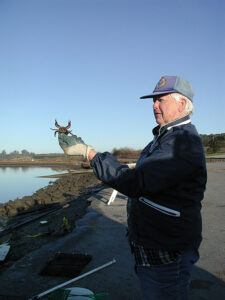Sea otters are not just adorable animals, they are voracious predators that help keep problematic invaders out of coastal waters.

Shirley Murphy, longtime volunteer, holds an invasive green crab at Elkorn Slough in 2004. • Photo Credit: Rikke Jeppesen
A recent study published in the scientific journal Biological Invasions reports that otters in the Elkhorn Slough estuary are keeping populations of the globally-invasive green crab at bay.
Rikke Jeppesen, estuarine ecologist at Elkhorn Slough National Estuarine Research Reserve in Watsonville, spearheaded the publication.
“I’ve studied green crabs in estuaries on three coasts and two continents for decades,” she says, “and this is one of the first pieces of good news we’ve gotten.”
Sea otters have been recovering from near extinction in California since the early 2000s. This new study provides the first evidence that recovery of this top predator has the benefit of controlling an invasive prey species.
The green crab, Carcinus maenas — a native of Europe — was unintentionally introduced to the Pacific coast of North America in 1989 in San Francisco Bay.
Since then, the green crab has been a successful invader to bays and estuaries, from Elkhorn Slough in the south to Alaska in the north.
By damaging seagrass beds or eating small prey that are important to migratory shorebirds, green crabs can have devastating effects on coastal habitats. Once established in their new habitat, green crab populations often persist with high numbers of individuals — except for at Elkhorn Slough.
Sea otter eating a female green crab carrying orange eggs at Elkhorn Slough. • Photo Credit: Michael Yang
Green crabs were first detected at the slough in 1994, and the population peaked in the early 2000s. Since then, the population has declined, never reaching the highs of its boom years again. During the same time period, the Southern sea otter population at the slough has the opposite pattern. The otter population has been highest at the slough when the green crab population has been lowest, and vice versa.
Elkhorn Slough is the only California estuary where otters have successfully reestablished substantial populations. It is also the only estuary in the state invaded by green crabs where crab populations have remained so low.
Otters certainly eat green crabs in Elkhorn Slough, but how many do they eat?
The investigators for this study used U.S. Geological Survey data on otter foraging to calculate that up to 120,000 green crabs per year could be consumed by the current otter population.
This is certainly enough to limit populations.
“We set traps and are delighted that we no longer catch large green crabs,” Jeppesen notes. “This is one more great reason to support recovery of top predators in coastal habitats.”
The team also found important habitat relationships. Much of the Elkhorn Slough estuary was diked in the past to cut off tidal exchange and allow for farming in former wetlands. Many of these areas still have only limited tidal exchange today.
It turns out that these areas with limited tidal exchange are places that sea otters generally avoid, and some are also the places where green crabs have their last holdout in the estuary.
Senior author Kerstin Wasson, research coordinator at the Elkhorn Slough National Estuarine Research Reserve, thinks this is one of the most critical messages of the study.
“Restoring the ebb and flow of tides — the lifeblood of the estuary — has so many benefit,” Wasson said. “Now we know these benefits include decreasing the abundance of invasive species by restoring natural food webs, with our coastal apex predator, the sea otter, on top.”